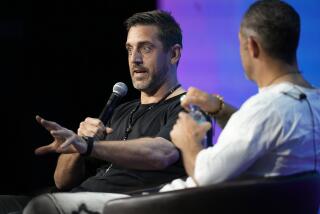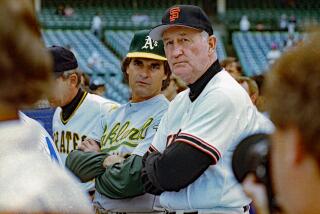Carl Rogers Dead at 85; Eminent Psychotherapist
- Share via
Carl R. Rogers, the psychologist and psychotherapist credited with revolutionizing the practice of psychotherapy in the United States and helping to father the human potential movement, died late Wednesday in La Jolla at the age of 85.
Viewed by followers and many critics as the most influential force in the field of psychology in the last 50 years, Rogers had been hospitalized for a broken hip and on Sunday suffered cardiac arrest. After three days in a coma, he died.
“Carl Rogers was a tremendous innovator in the field of psychotherapy,” said Faith Tanney, an officer in the American Psychological Assn. “His contribution was that of having the therapist or counselor be more of a human being.”
“He’s probably second only to Freud in many people’s impression in terms of his impact on the whole field of psychology and psychotherapy,” said David Malcolm, an associate of Rogers and professor of counselor education at San Diego State University. “He almost single-handedly brought about the revolution in therapy in this country by not believing in making diagnoses.”
While psychologists have incorporated many of Rogers’ techniques of warmth and empathy into the practice of psychotherapy, many have also faulted him for failing to address such troublesome questions as schizophrenia, sociopathy and the nature of evil.
“He felt somehow that the solutions to problems rested within the individual and that the therapist should bring them out,” behaviorist B.F. Skinner commented Thursday. “ . . . But I felt people are really changed by changing the world they live in.”
Rogers developed the “client-centered” theory of psychotherapy, in which a person-to-person relationship replaces the traditional doctor-patient relationship and the client shapes the direction and length of treatment.
The approach arose out of Rogers’ belief that individuals are always capable of growth and hold within themselves the solution to any problem. The role of the counselor, he believed, was simply to create the type of environment in which those solutions could emerge.
Although Rogers first applied his principles on a one-to-one basis as a psychotherapist, he moved during the 1960s into the encounter-group movement. Later, he applied the same theories in workshops aimed at resolving political conflicts and achieving world peace.
For example, Rogers worked with Catholics and Protestants in Dublin, blacks and whites in South Africa, and with Central American leaders. Last year, he traveled to the Soviet Union, where 1,500 people turned out for his workshops.
Dr. Jonas Salk, a longtime friend in La Jolla, said: “He had a kind of personal command and this inner peace which he was able to communicate and transmit to others and in groups in which he was present. He was like oil on troubled waters.”
“It seems to me I see his influence everywhere,” said Assemblyman John Vasconcellos (D-San Jose), who described Rogers as a second father. “It’s in schools, it’s in teachers, it’s infected almost all forms of therapy, and in organizational development work.”
Others credited Rogers with influencing, through his seminars and numerous books, the fields of medicine and business as well as the women’s movement and the civil rights movement.
“He was called sometimes the father of the human potential movement, which I think is a misnomer because he would not . . . take credit for the abuses and caricatures that have emerged under the name of the human potential movement,” said Douglas Land, who in 1969 co-founded with Rogers the Center for Studies of the Person in La Jolla.
“But the breakthroughs that took place, in terms of women’s liberation and civil rights, I think he contributed much to that in terms of teaching people to be honest with their feelings and to go for what they are.”
Rogers’ numerous books included “On Becoming a Person,” “The Clinical Treatment of the Problem Child” and “Counseling and Psychotherapy.” He was president of the American Psychological Assn. in 1946-7 and the first recipient of its Distinguished Professional Contribution Award in 1956.
Born Jan. 8, 1902, into a close-knit family in Oak Park, Ill., Rogers spent two years at Union Theological Seminary in New York City before switching to Columbia University Teachers College, where he received his doctorate in 1931.
At Columbia, he was influenced by the split between Freudians and the more scientifically oriented psychology of E.L Thorndike. Moving from there to the child study department of a Rochester, N.Y., social service agency, he began developing his own form of therapy.
At first Rogers was ridiculed and ostracized for “deprofessionalizing the profession,” said Malcolm, who recalled during graduate training in psychology in the 1940s going to meetings where actors would perform “burlesques” of Rogerian techniques.
But during the early 1940s, when Rogers published a small book on counseling returning servicemen, his influence began to permeate both that government-subsidized therapy and therapy as it was more widely practiced.
Rogers’ approach seemed to have an unusually broad appeal.
“Ordinary people have written in response to his books saying, ‘I feel like you understand me completely. You know what it’s like for me to be me,’ ” said Valerie Henderson, his assistant for the past 14 years.
” . . . He not only could uncover these profound truths, but he could communicate them in a very clear way that was not difficult for people to understand. He never wrote obscurely. Everything he said seemed to resonate in people.”
He was not, however, without critics.
Skinner, the famed behavioral scientist, recalled debating Rogers twice during the 1950s on the subject of controlling human behavior.
“I think he felt that I had very dangerous techniques,” Skinner said. “But I argued that other people had them too and they should be used only for the betterment of the species. I don’t think we ever disagreed on goals, but we did disagree on how to get there.”
In recent years, psychologists of many different schools have incorporated some of Rogers’ techniques. Yet many contend that his approach is inadequate for treating more seriously disturbed people.
“Many believe you have to do more,” said Tanney, a psychologist practicing in Washington, D.C. “As Freud was influenced by his Victorian, upper-middle-class population, much of Rogers’ early work was with very bright, upper-middle-class college students, not many of whom were schizophrenic or seriously disturbed. . . . With a schizophrenic, just providing warmth and a trusting environment would not help.”
Rogers moved from Rochester in 1940 to the University of Ohio, then the University of Chicago and the University of Wisconsin, where he served as a professor of psychology and continued to develop his approach.
In 1964, he moved to California as a fellow at the Western Behavioral Sciences Institute in La Jolla. Five years later, he and a dozen others co-founded the Center for Studies of the Person and began applying his approach to the emerging techniques of group therapy and encounter groups.
Gradually, the applications broadened.
During the Johnson Administration’s War on Poverty in the 1960s, Malcolm remembers, Rogers went to Philadelphia, where “group health care providers and community leaders were at each others’ throats on how to spend federal money.”
“That’s the first time he was involved in groups in conflict,” said Malcolm. “Remarkable things happened with the simple process of trusting people, listening, letting them feel respected and heard.”
In addition to his work in Ireland and South Africa, Rogers conducted workshops all over the world and in 1985 organized a meeting in Austria of 50 leaders of Central American countries and others aimed at responding to “the Latin American Challenge.”
On his 80th birthday, Rogers is said to have announced to a group of friends that he intended to devote the rest of his life to working toward world peace. To that end, he traveled last year to the Soviet Union at the invitation of the Soviet government.
“He was invited by the Ministry of Education to consult on individualizing education and fostering creativity,” said Vasconcellos. “His comment was, ‘If only my own government would do that.’ ”
Whether the Carl Rogers Institute for Peace, which he co-founded in 1983, will continue after his death remains to be seen, said Malcolm, who worked closely with Rogers on the project.
“Are we dependent on his charisma?” Malcolm wondered Thursday. “Philosophically, I walk step to step with the man. Now I’d like to see if I’m doing not just what he believed in, but what I believe in.”
In recent years, Rogers continued to travel widely. But worsening eye problems made it increasingly difficult for him to read. While in La Jolla, he could be found walking along the beach at La Jolla Shores or tending the garden at his Mount Soledad home.
“He liked succulents, more exotic types of plants,” said Henderson, his assistant. “I think it was very much in line with his whole approach, in that he liked to nurture the unusual plants and see them to fruition.”
On Saturday morning, Rogers fell at his home and broke his hip, Henderson said. He was taken to Green Hospital at Scripps Clinic, where surgeons replaced the ball of his hip.
His condition improved dramatically but on Sunday afternoon he suffered cardiac arrest, Henderson said. He was resuscitated but never emerged from the coma. He died at 11 p.m. Wednesday.
Rogers is survived by two brothers, a sister, two children, six grandchildren and three great-grandchildren. His wife, Helen Elliott Rogers, died in 1979.
Henderson said there will be a celebration of Rogers’ life Feb. 21 in Sherwood Auditorium at the La Jolla Museum of Contemporary Art at a time to be set. Services will be private.
More to Read
Sign up for Essential California
The most important California stories and recommendations in your inbox every morning.
You may occasionally receive promotional content from the Los Angeles Times.













